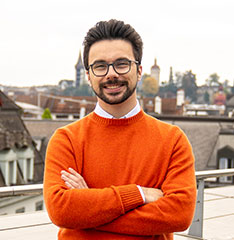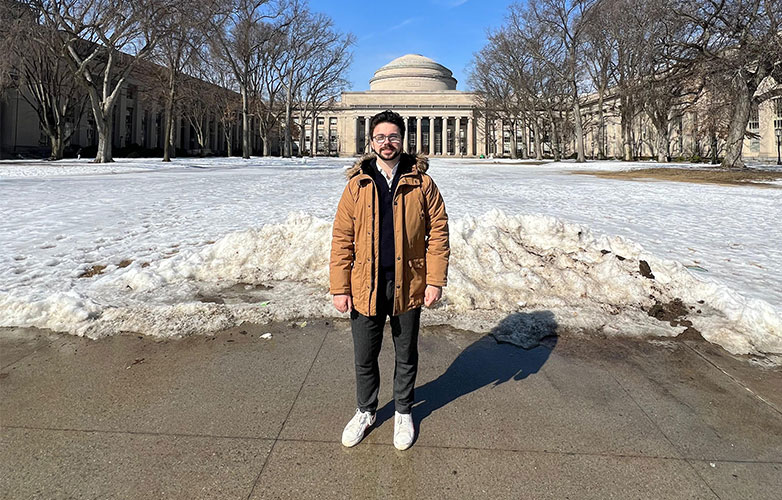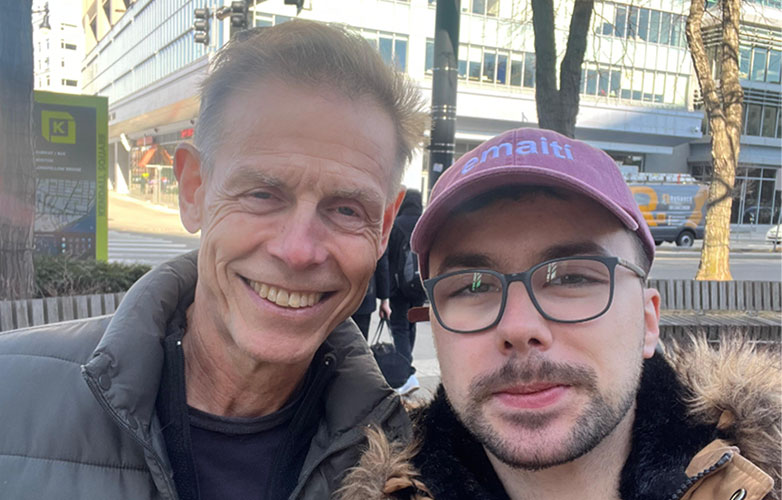
Human and animal behaviour with data science: Research projects by Rodrigo González Alonso
Rodrigo González Alonso’s journey has been a rich adventure across countries and research topics. In Spain, Finland, Italy and Switzerland, as well as at the Massachusetts Institute of Technology (MIT) in the U.S., he explored how data can be used to identify patterns in both human and animal behaviour.
Shortcuts: Interview | Info-Events | Programme Information | Contact | Professional Data Science Portraits

Rodrigo González Alonso is a graduate of the Master’s programme in Applied Information and Data Science at the Lucerne University of Applied Sciences and Arts (HSLU). He worked on several international research projects aimed at identifying patterns in human and animal behaviour, with the collaboration at the Massachusetts Institute of Technology (MIT) marking the highlight of his research experience.
Introduction
First of all, tell us something about yourself: What hashtags best describe you?
#GlobalJourney #AlwaysLearning #Curious
Tell us more about the hashtags.
#GlobalJourney reflects my path so far – from growing up in Spain, studying in Finland, doing an internship in Italy and now building my career in Switzerland, as well as the time I spent at Massachusetts Institute of Technology (MIT) in Boston. Each step has been formative and given me new perspectives on how people live, work and collaborate across cultures.
At the same time, #AlwaysLearning and #Curious describe how I approach both work and life. I’m the kind of person who likes to ask questions and explore new things, whether it’s through my studies, projects at work or simply through my everyday experiences. This curiosity often leads me in an unexpected direction, and the constant process of learning keeps me motivated and moving forward.

About your job: What are you doing at SIX Group?
At SIX Group, the company that operated the Swiss Stock Exchange, I work in the Financial Information unit, where we acquire, process and deliver financial data to clients. My role in the Strategy team is to enhance productivity by building and improving tools with Python and Power BI.
I work with both client and internal data to help colleagues design strategies that guide business decisions. A big part of this involves pricing and financial planning, and data science methods help us to be more accurate and flexible. At the same time, I like to explore more creative uses of technology, such as computer vision for reading contracts or small AI agents that handle repetitive workflows.
The goal of all this is to turn data into something practical that helps people work more efficiently and make better decisions. My job combines data science, technology and strategy and gives me the chance to contribute to projects that directly affect operations.
What did you do before and why did you join SIX Group?
I began studying Business Administration in Spain, and completed my studies with a double degree from a university in Finland. However, my interest quickly shifted towards the field of data, specifically business intelligence. This led me to move to Lausanne to do an internship at Philip Morris International, where I worked in the Business Intelligence team for IQOS. There was no existing data infrastructure, so I had the opportunity to experience firsthand how to build the data processes from scratch over the course of a year.
Later on, I joined SIX Group, where I found the scale and impact of my work and knowing that I can influence many companies to be very motivating. Additionally, as someone deeply connected to Spain I have always valued being engaged with my home country through my professional work, as SIX owns the Spanish Stock Exchange.
The projects
Please tell us about your research projects.
The first project was a dual collaboration with Professor Peter Gloor, a researcher at MIT, professor at the University of Cologne, and lecturer at HSLU. During this work, I travelled to MIT in Boston, where I assisted with experiments to measure which combination of psychological factors improved group performance by identifying the personality types within the teams to enhance its effectiveness. This opportunity also allowed me to spend time in Boston, where I experienced MIT firsthand, particularly the Systems Design and MIT Sloan School of Management department. This led to the joint publication of a paper.
I continued to work with Professor Peter Gloor afterwards, contributed to publishing a paper as part of the course Collective Innovation Networks (COINs) at HSLU, and then attended the COINs conference in Gorizia. Additionally, we are about to collaborate and publish a paper on recognising “happy cows” at the Mediterranean Ruminant Congress, where we will be co-authoring with my father, a veterinarian and professor.
This collaboration has been highly rewarding and was made possible thanks to HSLU.
Module Collaborative Innovation Networks (COINs)
How do teamwork, technology and human dynamics interact across borders? The international module Collaborative Innovation Networks (COINs) in the MSc in Applied Information and Data Science programme at HSLU, brings together students from Germany, Switzerland, Italy, Poland, and Finland to explore these questions in depth.
The module is led by Prof. Peter Gloor, researcher, author and founder of the COINs concept at MIT. He is known for his pioneering work on collaborative innovation, swarm creativity, and social network analysis.
Using smartwatches, phones and environmental data, students analyse how hybrid work settings influence collaboration, performance and group creativity. Each project uses data science, social network analysis and machine learning to discover what makes teams truly effective in terms of topics ranging from human energy patterns all the way to digital communication flows.
Many student projects are later published in research journals or presented at international conferences, making this module a gateway into real-world, data-driven innovation.
What data and methods did you use, and what insights did you gain or do you hope to gain?
My projects with professor Gloor used a wide range of data sources, which made them both challenging and exciting. In my thesis, I worked with tens of millions of Reddit comments and analysed how online discussions reflect emotions, values and group decision making. In another project in the COINs seminar, we studied WhatsApp group chats from students at the Polytechnic University of Madrid, which gave us a very different view of communication styles and group dynamics in an academic context. And more recently, we even looked at video recordings of cows that I collected during hikes in Switzerland, exploring how computer vision can help us identify indicators of animal welfare.

Results and Findings
How can your insights help our society?
My insights can help society by showing how we can make better use of the enormous amount of data we generate daily. The shared theme in the MIT experiments on finding the best team compositions and in professor Gloor’s Happy Cows project is that we don’t need to produce more data because it already exists. What matters is that we use the right methods to discover patterns that would otherwise remain invisible.
In that sense, the value lies in saving time and exploring new perspectives. Whether it involves improving how teams collaborate, understanding wellbeing in unexpected ways or making better decisions in business, the techniques I’ve learned about help us to see connections and opportunities that might get overlooked with traditional approaches.
What are your goals for your projects in future?
In the future, I’d like to apply what I’ve learned in these projects to new areas, especially in finance and business, where decisions are made quickly and often with incomplete information. The mix of the data and methods I used, from text analysis to computer vision, can be useful in many fields other than research.
At the same time, I’d like to stay connected to interdisciplinary projects. Working on topics like team performance and animal wellbeing gave me fresh perspectives, and I think that striking a good balance between occupational activities and non-occupational research produces mutually beneficial results.
How did your studies in the Applied Information and Data Science programme influence the projects?
My Master’s studies in Applied Information and Data Science strongly influenced these projects – inspiring me to explore new ideas and connect them to real-world problems as well as providing me with the methods and technical foundation, from advanced analytics to project work with classmates.
Most importantly, the Master’s programme created opportunities to work with real data and applied research, which allowed me to move beyond theory and test my ideas in practice.
What advice would you give to others starting on similar projects?
The most important advice I would give to someone starting on a similar project is to take enough time to plan it properly. It’s tempting to dive straight into the analysis, but understanding the limitations of the data early on can save a lot of frustration down the road.
I would also recommend looking for similar projects and learning from them. Exploring how others approached their methods can be a great source of inspiration and help you avoid common mistakes, save time and ultimately improve the quality of your work.
And finally: What new hashtag are you aiming for in future?
#Learning: I’m never done learning. In many ways, I’m only just getting started.
#Impacting: Data will continue to be the engine of growth for companies and society.
#ThinkingCritically: Being aware of where data and AI are heading – including the moral challenges, and preparing to face them responsibly.
We want to thank Rodrigo González Alonso for his dedication and for sharing these valuable insights.
Data is the resource of the 21st century!
Register and join us for a free online Information-Event:
Friday, 28 November 2025 (Online, English)
Monday, 12 January 2026 (Online, English)
Monday, 09 February 2026 (Online, German)
Programme Info: MSc in Applied Information and Data Science
More Field Reports & Experiences: Professional portraits & study insights
Frequently Asked Questions: FAQ


